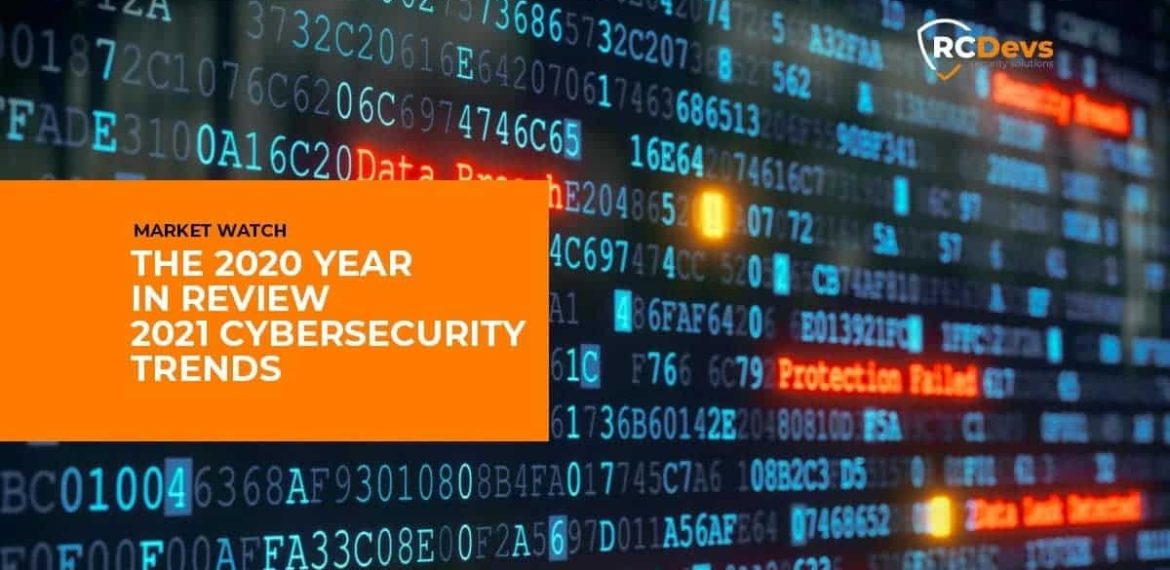
CyberSecurity – 2020 Year in Review & 2021 Trends
CyberSecurity – 2020 Year in Review & 2021 Trends
2020 was a chaotic year for cybersecurity; new threats and tactics were in place, but we also saw a dramatically changed attack surface as organizations around the globe shifted to remote working, where traditional network-based security technologies were rendered unused. We saw new, high-profile breaches that were representative of the gap in proactive efforts required.
In this article, we examine the following in the context of our learnings from 2020, and how you can prepare for 2021:
– 2020 Year in Review
– Cybersecurity Trends for 2021
The 2020 Year in Review
The Rise in Phishing Email
There was a 350% increase in phishing websites during the first quarter of 2020, according to the United Nations, with the majority using the coronavirus pandemic as an exploit.
The organization’s counterterrorism chief Vladimir Voronkov told the UN Security Council that the surge in phishing sites was part of a “significant rise in cybercrime”, according to ABC News.
The spread of Privacy Regulations
The widespread adoption of GDPR Regulation followed by EU and also other countries are establishing privacy regulations on par with the EU’s GDPR opens up the door for countries and the companies within them to do business on a broader scale because of their “trusted status”. In other words, access to other markets will ultimately depend on a country’s and company’s alignment with and adherence to globally accepted privacy best practices.”
The EU standards essentially require other countries to implement privacy regulations that are on par with the terms of the GDPR.
The majority of the world will be covered by data privacy regulations by 2023.
2021 Cybersecurity Trends
- Remote workers will be the focus of cyber criminals through 2021
- Legacy security architecture like VPNs will be the weak link for many organizations
- The impact of breaches in the healthcare sector may be deadly
- Financial organizations beware, more attacks are coming
- The adoption of new technologies and an increase in internet users means most of the world’s population is at great risk of data exposure
1. Remote workers will be the focus of cyber criminals through 2021
If there’s anything we’ve learned from 2020 so far, it’s that remote workers are a focal point for cyberhackers – and we expect this to continue into 2021.
But why are remote workers a target for cyber attackers?
There are a couple of main reasons:
- Remote workers are far more likely to use their own devices and personal Wi-Fi connection for their work, which simply aren’t as strong and protective as corporate devices and networks. This makes hacking a much easier job for cybercriminals.
- Cybercriminals are aware that a lot of businesses were thrown in the deep end with the pandemic. Businesses weren’t set up for remote working and therefore didn’t have the right security protocols in place.
Implementing the right tool for work from home policy is the utmost important objective.
Companies are aware of it and that is the reason it is increasing the budget on CyberSecurity for 2021 rather than reducing it.
2. Legacy security architecture like VPNs will be the weak link for many organizations
The National Security Agency (NSA) has issued a new cybersecurity advisory warning that virtual private networks (VPNs) could be vulnerable to attacks if not properly secured.
“Many organizations currently utilize IP Security (IPsec) Virtual Private Networks (VPNs) to connect remote sites and enable telework capabilities. These connections use cryptography to protect sensitive information that traverses untrusted networks. To protect this traffic and ensure data confidentiality, it is critical that these VPNs use strong cryptography. This guidance identifies common VPN misconfigurations and vulnerabilities,” says the NSA.
3. The impact of breaches in the healthcare sector may be deadly
A new report by Black Book Market Research predicts that data breaches in the healthcare industry are likely to triple in volume in the coming year. The “2020 State of the Healthcare Cybersecurity Industry” report surveyed over 2,400 security professionals.
With this increase in cyber attacks on healthcare organizations and the advanced nature of these threats, including those that attack web applications, organizations in healthcare may also need to re-evaluate their approach to security.
4. Financial organizations beware, more attacks are coming
As per the report, cybercriminals will continue to target Bitcoin and other cryptocurrencies next year. “Bitcoin theft will become more attractive as many nations plummet into poverty as a result of the pandemic. With economies crashing and local currencies dropping, more people may become involved in cybercrime, leading to more cases.”
Financial services organizations and other firms that are responsible for the security of consumer financial data must remain vigilant in their cybersecurity efforts throughout 2021. The high value of financial data, including Social Security numbers, banking details, and more, makes it a lucrative target for cybercriminals.
However, this shouldn’t prevent organizations from implementing new technologies or continuing remote work. With the right security strategies and solutions, organizations can benefit from new technologies and support their remote workforce without exposing themselves to additional risk.
5. The adoption of new technologies and an increase in internet users means most of the world’s population is at great risk of data exposure
History shows that attackers refine their methods to take advantage of global events and the adoption of new technologies. In fact, online crimes reported to the FBI’s Internet Crime Complaint Center (IC3) have nearly quadrupled since the beginning of the COVID-19 pandemic. This comes as no surprise, as there were close to 4.6 billion active internet users as of July 2020, which represents 59% of the world’s population. The number of internet users will continue to increase in the coming year, and 84% of organizations will continue to support remote work even after a stay at home orders are lifted. Combining these trends with the rapid development and adoption of technologies like 5G (which enables malicious actors to execute attacks and move data much more quickly) suggests that we will see an increase in the number of people around the world who are impacted by data breaches.

